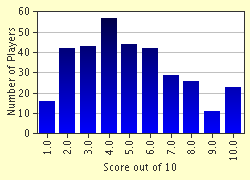Quiz Answer Key and Fun Facts
1. A cost that changes with the number of units produced, but that can never be zero, is what kind of cost?
2. Manufacturing overhead is allocated as what kind of cost?
3. A cost that changes with the number of units produced and is zero when no units are produced is what kind of cost?
4. A cost that remains unchanged across the relevant range of units produced is what kind of cost?
5. A company has the following cost data for the month:
Beginning Raw Materials Inventory: $12,500
Raw Materials Purchases: $47,000
Ending Raw Materials Inventory: $8,200
Beginning Work in Process Inventory: $4,700
Ending Work in Process Inventory: $2,800
Beginning Finished Goods Inventory: $27,600
Ending Finished Goods Inventory: $29,200
Direct Labor Costs: $64,400
Manufacturing Overhead Costs: $14,500
What is the Cost of Goods Sold for the month?
6. The costing system that tracks costs to a department or work group and assigns the cost to products produced by that department or work group is which kind of costing system?
7. A costing system that tracks costs to a specific lot of a product is which kind of costing system?
8. The costing system that initially assigns all costs to Cost of Goods Sold and then removes them to the appropriate inventory values is which kind of costing system?
9. In an Activity Based Costing (ABC) system, plant insurance is most likely to be which level of cost?
10. A company makes one product, which has variable manufacturing costs of $3.25 per unit and variable selling and administrative costs of $1.17 per unit. Fixed manufacturing costs are $42,300 per month, and fixed selling and administrative costs are $29,900 per month. The company wants to earn an average monthly profit if $15,000, and they expect to produce and sell an average of 40,000 units of the product per month. What is the minimum selling price management can be expected to set to meet their profitability goals?
Source: Author
Jayman0755
This quiz was reviewed by FunTrivia editor
Leau before going online.
Any errors found in FunTrivia content are routinely corrected through our feedback system.

